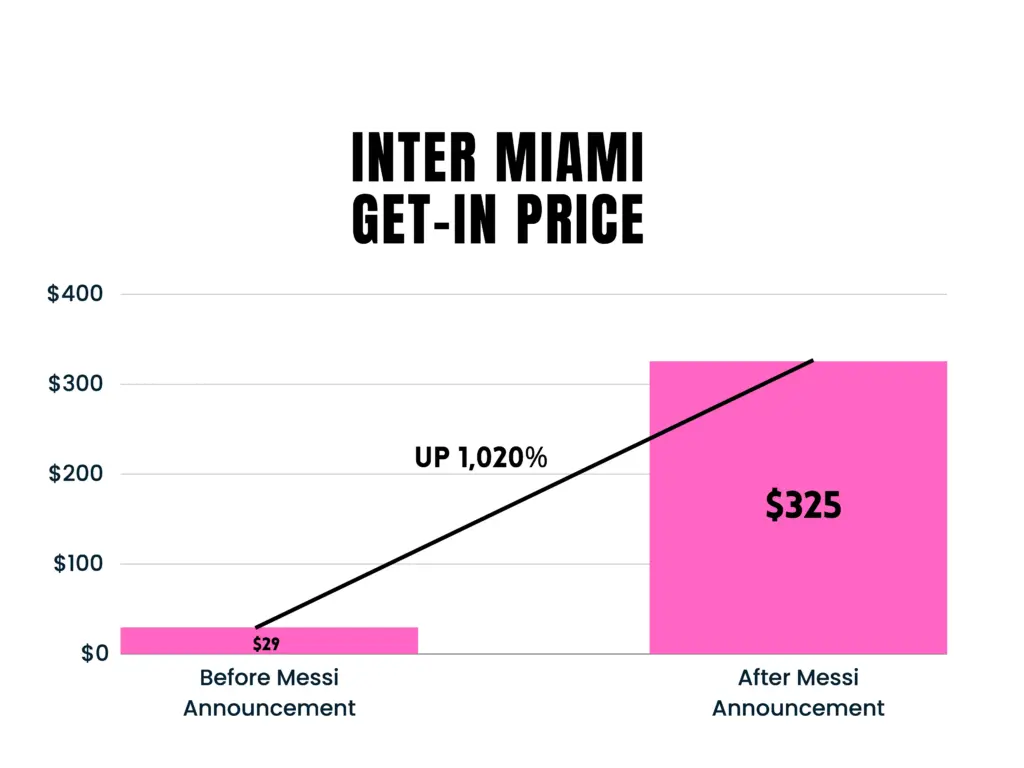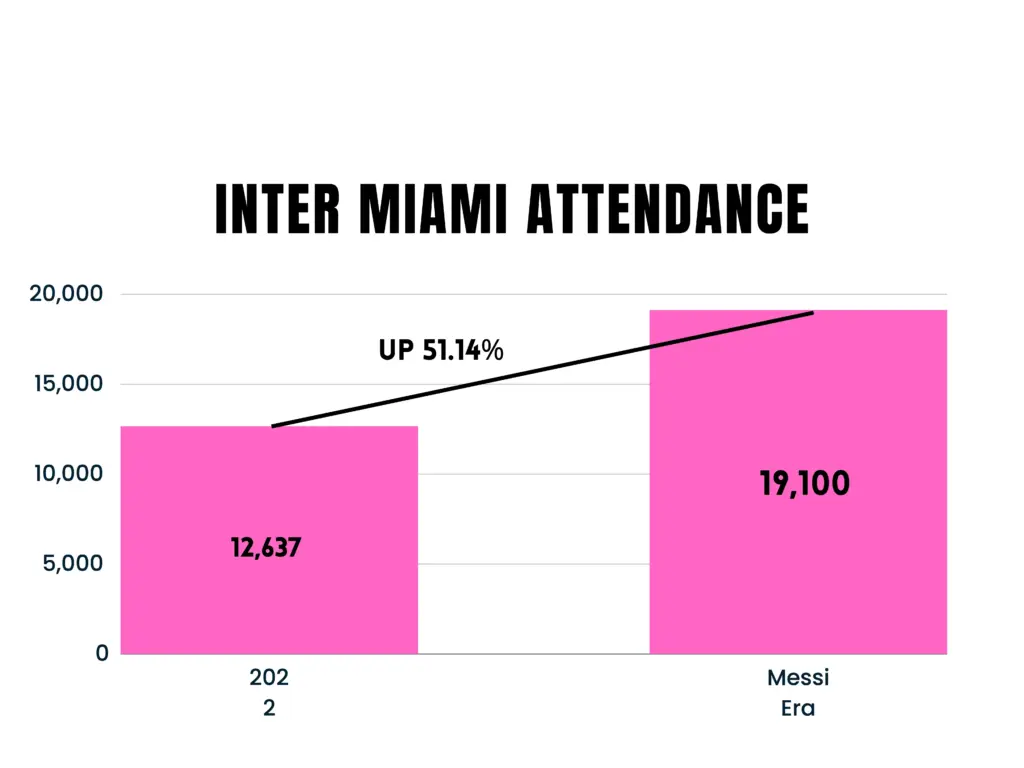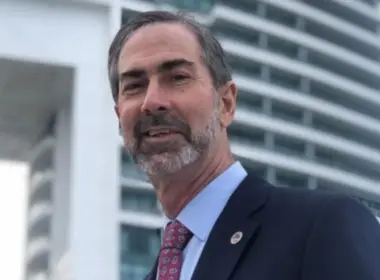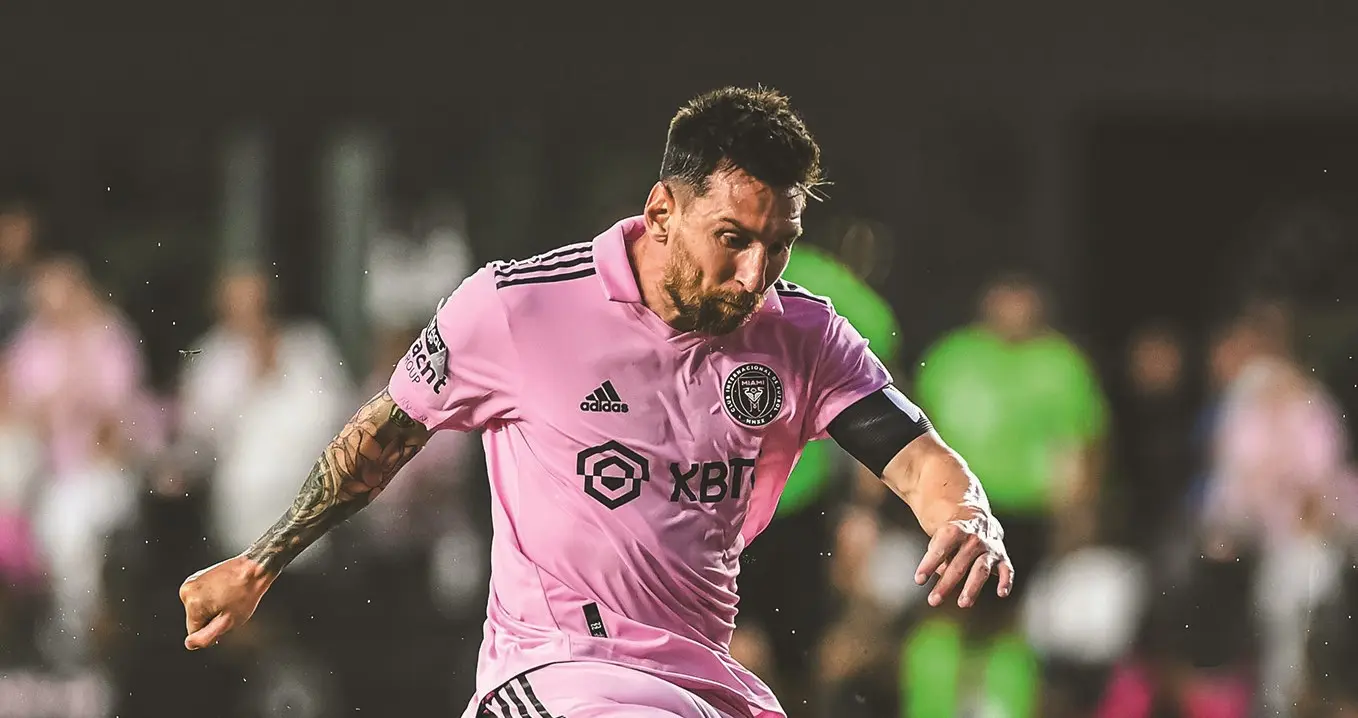The crowd is roaring, a deafening cacophony of jubilance and raucous celebration as feet stamp and whistles pierce the air. Smoke bombs are going off with such gusto that it’s nearly impossible to see the glistening green field below. As they dilute, there’s a glimpse of a small figure in pink sprinting across the grass, arms spread wide. He jumps into the embrace of his teammates, immediately engulfed in a pile of joyous pink jerseys. He’s five-foot-seven, 36 years old, and currently one of the biggest driving forces of the South Florida economy.

He’s Lionel Messi, soccer’s brightest star, considered by pundits to be the best player of all time – and, now, the captain of Major League Soccer’s Inter Miami CF.
Only a few months ago, DRV PNK Stadium was much emptier. In 2022, Inter Miami had the lowest attendance in Major League Soccer (MLS) with an average of 12,637 fans per game. The average ticket price came in at around $152 and the club’s Instagram followers were steady at about one million. Nowadays, all 19,100 seats at DRV PNK Stadium are sold out, or close to it.
Average ticket prices went up 459 percent to $850 in the month after the club announced Messi’s signing. Tickets for his debut skyrocketed to as much as $110,000. On Instagram, @intermiamicf ’s followers swelled to well over 14 million. But Messi’s impact extends much further than just Major League Soccer, or even soccer in general. Because this isn’t just Messi’s moment. It’s Miami’s moment.
Miami has been a home for international sporting events for some time now. The Miami Open tennis tournament, for one, has been held here every year since 1987. But with the arrival of Messi, Formula One, the FIFA World Cup, and tournaments like the FIBA 3×3 AmeriCup and the World Baseball Classic, it’s now a veritable capital for global sports. “All of these events are moving to Miami because Miami is growing,” says economist and University of Miami professor Alex Horenstein. “It’s part of a circle. As the city grows and becomes appealing for businesses, it also becomes appealing for entertainment.”
While we clearly can’t place Miami’s recent explosion of economic growth on the shoulders of one athlete or even one event, however, there’s no understating the impact of Lionel Messi’s arrival or the myriad international sporting events attracting millions of visitors to the area.




HARD ROCK REIGNS
For a city that relies on tourism as one of its economic pillars, events like the Miami Open or the F1 Miami Grand Prix are huge gets, despite only occurring annually. The Grand Prix – held this year at the Miami International Autodrome around Hard Rock Stadium – boosted the local economy by a whopping $449 million. During the course of “race week,” visitor spending reached over $195 million, with more than 270,000 fans from around the world drawn to attend the race and associated events. While some of the infrastructure was already in place – the Miami GP is considered a “street race,” so most of the asphalt used for the racetrack was already in use by regular commuters – the construction-related economic impact on the Greater Miami economy reached $230 million. A huge campus was constructed surrounding the stadium, complete with grandstands, art installations, food and merch booths, restaurants and bars, and, of course, VIP clubs for the upper-echelon teams. Thousands of workers were hired to staff the event space, from janitors to security guards to bartenders. Vendors, most of them local, lined virtually every inch of the 3.4-mile track.

The Miami Open tennis tournament, which has utilized the same area at Hard Rock Stadium since moving from Key Biscayne in 2019, is an even lengthier affair. Over the course of 12 days, the grounds are filled with hundreds of thousands of fans, with over 14,000 hotel rooms reserved. This year, the event saw a record-breaking 386,000 attendees with four individual matches setting records for attendance. The economic impact of the tournament was roughly $390 million – but it took a big move and millions of dollars in investment to make it so.
In fact, a few years ago it seemed like Miami was going to lose the tournament altogether. Bruce Matheson, a local resident who controlled the land on which the event was held in Key Biscayne, refused to allow a proposed $50 million renovation of the site. After a series of lawsuits, it seemed the Miami Open would be no more. Then Stephen Ross, owner of the Miami Dolphins football team, stepped in.

The billionaire real estate developer had already spent $550 million renovating Hard Rock Stadium, where the National Football League’s Miami Dolphins play, when he approached IMG, owner of the Miami Open, with an offer. With an additional $72 million provided by Ross to transform the stadium and surrounding area into a state-of-the-art tennis venue, Hard Rock became the home of the Miami Open. The hundreds of millions in local revenue were saved and now, “we can do more things,” Tom Garfinkel, CEO and president of Hard Rock Stadium, said back in 2019. “This place has a much larger footprint.”

“I think of Hard Rock as being the anchor tenant that has promoted a lot of this growth,” says Dr. Erin McNary, associate professor of sports administration at the University of Miami and the director of the Global Sports Industry Conference. “When it was renovated and they added more premium suites, the open-roof concept, and increased the stadium capacity… that made [Miami] more attractive.” The increased capacity meant the Super Bowl could now be hosted here, which it was in 2020. And it didn’t only make the stadium attractive to sporting competitions. Mega stars like Taylor Swift and Beyonce, who have their own economic impacts on cities they tour in, have since visited or plan to.
INTERNATIONAL PROGRAMMING
Though Hard Rock is now the undisputed nexus of international sport in Miami, other local stadiums and arenas have also begun to take on global events beyond their regular programming. In 2022, the second FIBA 3×3 AmeriCup in Miami took place outside the downtown Kaseya Center (formerly known as FTX Arena) where the National Basketball Association’s Miami Heat play. The International Basketball Federation (also known as FIBA) is the governing body of basketball. It puts on international tournaments similar to the FIFA World Cup, with players representing 161 countries divided by age groups and gender. The 3×3 AmeriCup included 18 different countries’ teams (both men and women) from the Americas, playing in a condensed version of the usual game with a modified points system and adjusted rules.
“If you look at the FIBA 3×3 engagement, the Chinese market was super engaged because they are completely supportive of and love basketball,” says Dr. McNary. “That event draws fans from all over the world.” It also came on the heels of FIBA America’s new headquarters opening in Miami three years ago, after the organization decided to relocate from Puerto Rico. “This region has been so important for international basketball over the years and now we have an excellent location to attend to our daily business as it relates to governing basketball in the zone,” said FIBA President Hamane Niang at the unveiling in 2020.
In April of this year, the Kaseya Center also hosted UFC 287, a mixed martial arts competition in the Ultimate Fighting Championship (UFC). UFC’s return to Miami after 20 years was a huge success, with a total of 19,032 fans in attendance. Gate revenue was $11.9 million, according to UFC President Dana White, outstripping Madison Square Garden’s event (UFC 281) in November 2022, which brought in $11.5 million featuring the same title fight between Israel Adesanya and Alex Pereira. With that number, Miami’s fight became the highest-grossing event in the arena’s history and the sixth-highest-grossing in UFC history.

At LoanDepot Park, where Major League Baseball’s Miami Marlins play – an international team in its own right, with a baseball academy in the Dominican Republic – most of the 2023 World Baseball Classic (WBC), including the quarterfinals, semifinals, and championship, was held. The Park became the first venue in tournament history to host games in all three rounds of a WBC in the same year. Teams ranging from Israel to Nicaragua competed in the tournament that Japan eventually won over the U.S.
The event also heralded another first – the first and only time a non-stop flight from Japan has flown into Miami International Airport: a charter flight containing most of the Japanese national team. Baseball, once known as “America’s favorite pastime” has now overwhelmingly infected Japan and Latin America, so much so that, on the World Baseball Classic’s website, you can now pick from three languages: English, Spanish, or Japanese.
Over 1.3 million fans attended the tournament across its four locations in Asia and the U.S., making it the highest-attended WBC since its inception in 2006. Eleven of the 15 games were played at LoanDepot Park, which seats 36,058; all were sold out. Some 6.5 million viewers watched the final game in Miami, making it the most-viewed WBC game of all time. Though the game aired at 8 am on a Wednesday morning in Japan, 42.4 percent of all Japanese households tuned in to the Final. Indeed, two of the four most-watched games in tournament history took place this year in Miami. “That’s a lot of eyeballs on our city,” says Dr. McNary. And those eyes came from everywhere. In Taiwan and Mexico, viewership increased by over 100 percent compared to 2017. Canada (44%), Korea (36%), and Puerto Rico (11%) also saw significant increases. In the U.S., streams of the final game far surpassed the previous record set in 2017 by over 69 percent. Overall, people from 163 countries and territories watched the tournament with 63 different media partners broadcasting in 13 different languages.
OUT OF THE BOX
Then there are the less traditional sports that have found homes in Miami. Esports is one, the name given to professional video game competitions. Just this year, FURIA, a Brazilian gaming company, opened its first public venue in the U.S. in Wynwood, Miami’s art district. The brightly colored building unites amateurs and professionals alike, giving casual gamers the chance to use FURIA’s computers and LAN connections to play with their friends, while also showcasing professional gamers who stop by to play “show matches” for fans. The company raised $4.5 million in funding in 2021 and now has over 200 employees. It’s one of many esports ventures trying to make it in Miami.
“I think there’s tremendous opportunity for more [esports] tournaments and growth here,” says Dr. McNary. “Especially if you look at the investment from the Asian market into some of these sports.” Asia made up 56 percent of esports revenue in 2022, but there are many in the U.S. who are capitalizing on the opportunity professional gaming presents – and trying to fill the employment pipeline with capable, homegrown animators and designers.
In 2015, Miami-Dade College’s Miami Animation and Gaming International Complex (MAGIC) opened, providing students with a new program that, besides academics, includes an esports component, referring to those involved as “student-athletes.” On the MAGIC website, Miami-Dade College (MDC) says it “recognizes that esports can help create a path to lifelong success and strives to enrich the lives of participants by providing quality coaching, facilities, and support services.” MDC Esports is currently recruiting players for games like “VALORANT,” “Rocket League,” and “Super Smash Bros. Ultimate.” Students must be enrolled at MDC and in the college’s Esports Club with an average GPA of 2.0 or higher to enroll in the program – similar to requirements held by many universities for their student athletes.
Perhaps the most niche sport to enter the Miami scene, however, is drone racing, another competition that’s attracted lots of overseas investment. Still in its infancy, the fast-growing sport has been connected to Miami since its inception seven years ago, when the city hosted the DRL’s very first race at Hard Rock Stadium. This year, it returned to Miami with its championship event, aptly named Miami 3-0-FLY (a play on Miami’s “305” area code) at LoanDepot Park. The competition transformed the stadium into a neon-lit aerial course where professional drone pilots raced their custom drones at speeds up to 90 miles per hour. A crew of over 100 was on-site for the event, which packed the baseball stadium.
Sponsors of the League include international brands like Google Cloud, SkySports, and Champion, and the DRL now has over 5.4 million TikTok followers. In 2022, it claims to have reached more than 320 million households through its media partnerships with NBC, ESPN, and FOX Sports. And it’s still growing.
With over 40 events now completed throughout the world and a total of 80 million fans worldwide, according to Drone Racing League CMO Anne-Marie Gianutsos, the high-tech sport is reaching a new generation of consumers. The league calls these 16-to-34-year-olds “Tech Setters.” Seventy percent don’t even watch traditional sports.
“The days of following the same sports you played in gym class are over,” DRL President Rachel Jacobson says. “Today, kids are flying drones, connecting on digital platforms, and learning about STEM in school; they are the future innovators in AI, Web3 gaming, and emerging technology, and they love the Drone Racing League because our sport celebrates them.”
While not altogether untrue, that first sentence might be a slight overstatement, and the proof lies at DRV PNK Stadium. There, an entire generation of children are learning to love soccer; playing it in school, in clubs, on public fields with their friends, and in the new soccer academies that are beginning to pop up all over the county. They follow Lionel Messi – and, by extension, Inter Miami – with a close eye and enthusiastic verve. They are the now and future consumers, and the impetus for the growth in soccer equipment sales across the U.S., which rose to $437.8 million in 2022, according to Statista.
“If you look at soccer in the U.S., it’s continually growing,” Dr. McNary says. “You’re seeing teams pop up in places like St. Louis, Missouri. Even in those smaller markets, there’s incredible growth. And that speaks to the growth at the youth level. At the end of the day, you’ve got to have your youth on board.”
Youth sports tourism is an economic factor that largely goes unnoticed, but soccer, with its academies and camps, is uniquely built for it. One of the best examples in Miami is the Barça Academy Pro Miami, a grassroots soccer academy owned and operated by FC Barcelona. “We may see more of that sort of stimulation not only excite kids, but also develop elite talent,” says Dr. McNary. “If you don’t have investment at the youth club level, well, obviously, your fans are going to grow up and they’re going to have kids, so we have to complete the cycle.”
THE FOOTBALL FACTOR
With Messi’s arrival, Miami is now a ripe market for the “beautiful” sport. But even before the Argentinian superstar stepped foot in the city, soccer had already identified Miami as a potential growth market. In 2018, CONCACAF, the Confederation of North, Central American, and Caribbean Association Football, moved its headquarters here with the objective of growing soccer in North America.
“The opening of our new headquarters in Miami… underpins the great work we are doing across the Confederation and the journey that we have taken to grow football in this city and across the region,” CONCACAF President Victor Montagliani said at the time. The office now houses over 50 employees and offers the organization’s 41 member associations a centralized location with easy air access via Miami International Airport. (It still maintains their Central American hub in Guatemala as well as offices throughout the globe.)
Outstripping that, in August FIFA (the Federation Internationale de Football Association and soccer’s governing body) announced it would be opening a new office in the Miami suburb
of Coral Gables, an affluent area with an array of Class A office space. The organization boasts 209 members (on par with the United Nations’ 193 members) and is arguably the most prestigious sports organization in the world. Its new office will be dedicated to the imminent arrival of the 2026 FIFA men’s World Cup, in which Miami is one of 11 U.S. cities acting as host. Though nobody could possibly name Messi the catalyst for this – he had only just joined Major League Soccer at the time – it is certainly fortuitous.
The Argentine has been linked to an economic surge throughout South Florida in everything from sales of soccer balls to airline tickets to the ever-present hospitality industry. In Fort Lauderdale, where Inter Miami’s current stadium lies until a new one is constructed close to the Miami International Airport (MIA), the effect is already showing. Fort Lauderdale Mayor Dean Trantalis says Messi has “jump-started economic growth, investments and opportunities that have made an impact not just on South Florida, but the state as a whole. Hospitality is leading the pack, catering to those traveling from out of town or looking to cheer Messi on.”
Brightline, Florida’s high-speed rail which provides service to Fort Lauderdale from Miami and vice versa, has begun providing added transportation during Inter Miami games. Flights from Messi’s home country of Argentina to MIA have been steadily increasing, with August 2023 set to outpace August 2022 by over 3,000 passengers. It seems every local business within a 100-mile radius is providing some sort of special or deal or watch party. Subscriptions
to the MLS Season Pass on Apple TV+ have more than doubled since Messi joined Inter Miami. Real estate analysis firm RentCafe is predicting a jump in the market where Messi eventually buys a home. “The arrival of a high-profile figure like Lionel Messi in South Florida could generate increased attention and interest, potentially impacting the real estate market,” a spokeswoman wrote in an email to the Palm Beach Post. “His international popularity could also increase tourism to Miami, potentially impacting the demand for short-term rentals.”
Developer Oscar Roger, who is building Coral Gables’ first short-term rentals hotel – the Avenue – is thrilled by the prospect. “Messi’s arrival can do nothing but improve the demand by visitors who want to come here to see the superstar. The demand is going to really blossom once the Inter Miami stadium is finished in Miami.”
Meanwhile, Messi’s pink No. 10 was the top-selling jersey across all sports from mid-July, when he was announced, to mid-August, on Fanatics. The first 24 hours of sales were the best of any player-changing teams across all sports, edging out Cristiano Ronaldo with Manchester United, NFL quarterback Tom Brady with the Tampa Bay Buccaneers, and NBA superstar LeBron James with the Los Angeles Lakers. To put it in perspective, last year Messi’s Barcelona jerseys garnered a whopping $130 million – $14 million more than the total revenue of the current (emphasis on “current”) top-earning MLS team, Los Angeles FC. And his Miami jersey should outdo that.
“Messi is almost a weekly event,” University of Miami’s Horenstein explains, citing the difference in impact between yearly events like the Miami Open and Messi’s arrival. “I don’t think there’s any figure more international than Messi… [and] soccer is probably the most international sport.” It follows, then, that thousands of international fans will travel here to see the most decorated soccer player in the world play in a city that already boasts a history of globalization.
While it’s still too early to tell exactly the capacity of Messi’s impact – economically, culturally, and socially – it’s not a forgettable one. Consider the impact on Paris Saint-Germain FC when Messi moved there. A MARCA report showed that the club subsequently generated over $750 million through new sponsorship deals, merchandise sales, ticket purchases, and the uptick in social media followers. And those dollars can and will get fed back to the city, because every ticket purchase means money spent on travel to the game or lodging in the area.
Without argument, Messi is currently the biggest international athlete in the U.S. But, in a city now on the trajectory of becoming the sports capital of the world, he’s just one more piece of the puzzle.












